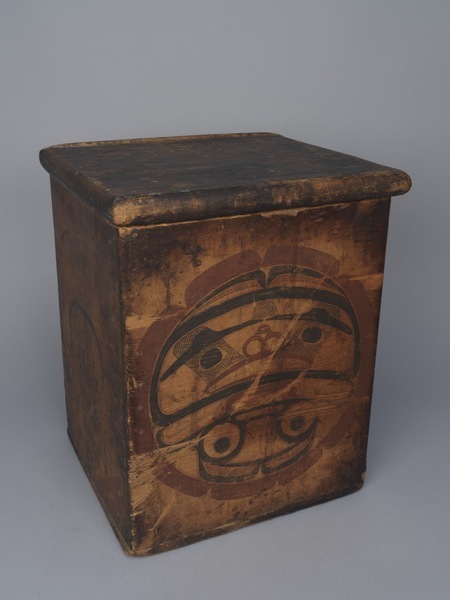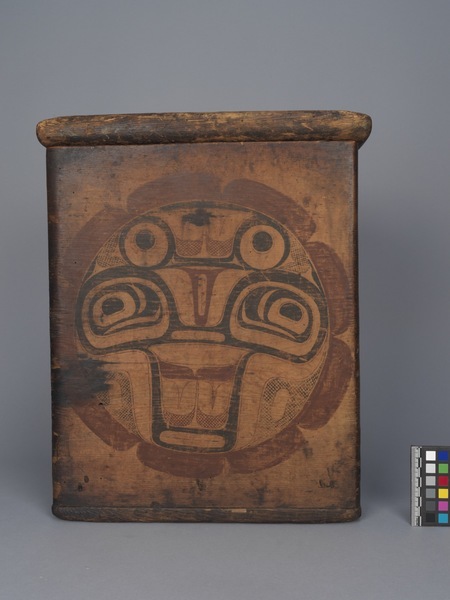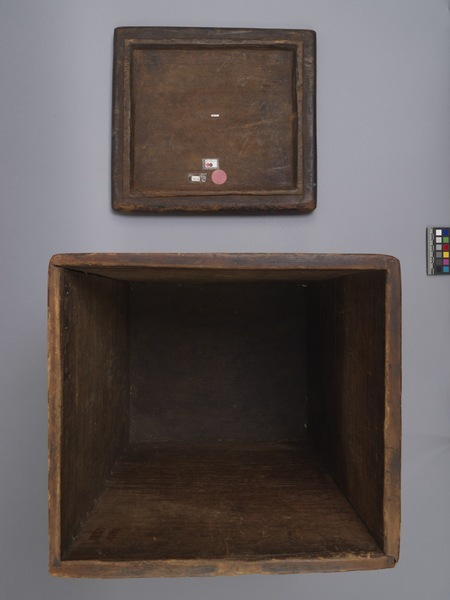Bentwood Box Item Number: 3260/79 a-b from the MOA: University of British Columbia




Description
Red cedar bentwood box (part a) with lid (part b). The box has three bentwood corners, curved and rounded, with pegs at the fourth corner. The lid has rounded edges, and is slightly thicker than the base. The front and back have circular paintings, with a different design inside each. Both have a red scalloped (U-forms) design around the entire outer edge of the circle. The ends of the box have simpler ovoid style designs. Designs are painted using mineral-based pigments.
History Of Use
Bentwood storage boxes and chests were a significant ‘canvas’ for 18th and 19th century Northwest Coast painters. Questions of attribution for boxes such as this example are challenging to resolve when the long history not only of artistic creativity and change but also trade, intermarriage, and other influences among coastal neighbours is taken into account (McLennan and Duffek, The Transforming Image: Painted Arts of Northwest Coast First Nations, 2000.) There are several different Central or Northern cultures of which to attribute this object including Haisla, Haida, Heiltsuk, Tsimshian, or Tlingit.
Narrative
Purchased by the donor from a Christie's Auction in 1996. Previously from the James & Marilyn Bergstrom collection. Exhibited in "The Box of Daylight" exhibition at the Seattle Art Museum in 1983; also discussed in "Form and Freedom: A Dialogue on Craftsmanship and Aesthetics" (Bill Holm and Bill Reid, 1975). Before entering the art market, this meticulously constructed box with its unusual and inventive paintings was owned by the family of David Peele, a descendent of Kaigani Haida Chief Saanixaat, of New Kasaan, Alaska. Family history defined the box as being of Haida origin. Stylistically, however, attributing the box to a Haida maker is less certain. The box still has its original lid, which is carved with a slightly raised lip on one end -- a style most common on the central coast, from the Heiltsuk up to the southern Ts’msyen. On the box front, moreover, the creature depicted inside the circular form may be compared to a number of known circular compositions from the central coast with human figures inside, including a monumental house-front painting photographed in old Bella Bella in 1873.
Item History
- Made in Alaska, USA ? between 1860 and 1880
- Owned by Elspeth McConnell before August 12, 2017
- Received from Elspeth McConnell (Donor) on August 12, 2017
What
- Name
- Bentwood Box
- Identification Number
- 3260/79 a-b
- Type of Item
- box
- Material
- red cedar wood and paint
- Overall
- height 42.5 cm, width 35.0 cm, depth 32.0 cm
- Part A
- height 39.5 cm, width 33.0 cm, depth 29.5 cm
- Part B
- height 4.0 cm, width 35.0 cm, depth 32.0 cm
Who
- Culture
- Tlingit ? or Haida: Kaigani ?
- Previous Owner
- Elspeth McConnell
- Received from
- Elspeth McConnell (Donor)
Where
- Holding Institution
- MOA: University of British Columbia
- Made in
- Alaska, USA ?
When
- Creation Date
- between 1860 and 1880
- Ownership Date
- before August 12, 2017
- Acquisition Date
- on August 12, 2017
Other
- Condition
- fair
- Accession Number
- 3260/0079 a-b